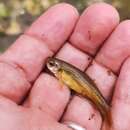Biology
provided by Arkive
The daska is a short-lived species (2) with a high level of resilience, capable of quickly re-establishing depleted sub-populations (1). Spawning occurs from December to March, and the diet includes invertebrates and plants (2).
Conservation
provided by Arkive
There are currently no known conservation measures targeting this species.
Description
provided by Arkive
Typical of most cyprinids, the daska is a small, silvery-brown fish, sometimes with a slight purplish sheen in the light, but no remarkable colours or pattern. The fins and tail are virtually transparent, and the tail is forked.
Habitat
provided by Arkive
Occurs in springs and associated wetlands and in lowland water courses with little current (2).
Range
provided by Arkive
Restricted to parts of the Peloponnese, Aitolo-Akarnania and Lefkas Island, Greece (1) (2).
Status
provided by Arkive
Classified as Least Concern (LC) on the IUCN Red List 2006 (1), and listed on Appendix III of the Bern Convention (2).
Threats
provided by Arkive
The daska is threatened by water extraction and pollution within its range, although in general the population is considered safe with no apparent long-term decline. While some local sub-populations have been severely impacted, many are expected to recover if conditions improve, because of this species' ability to quickly rebound from depleted numbers (1).

